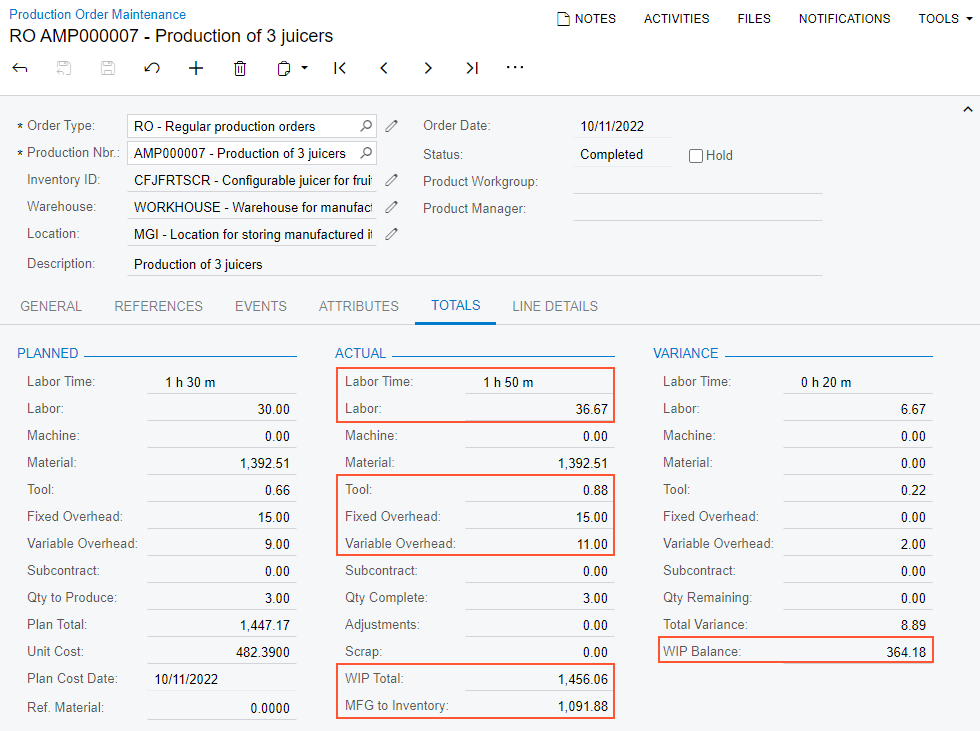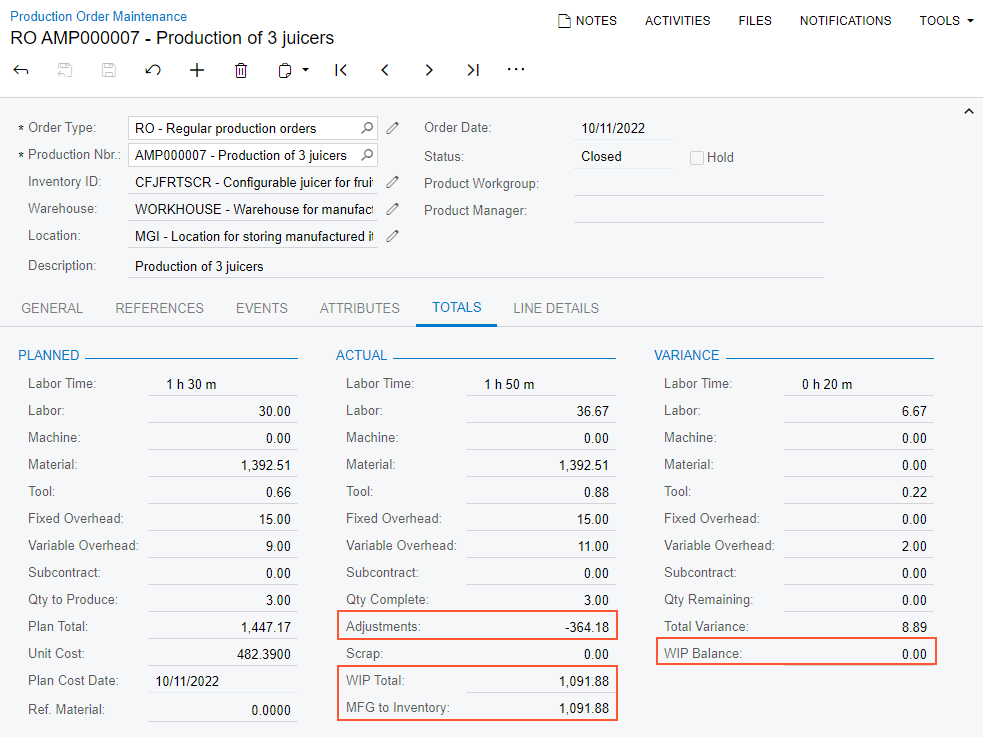Scrap and Waste in Production: To Process a Production Order with No Scrap Settings
The following activity will walk you through the process of recording item production that includes scrapped items when no specific actions are required for scrapped items.
Story
Suppose that the GoodFood One Restaurant has ordered three juicers from the SweetLife Fruits & Jams company. Further suppose that during juicer assembly, a shop-floor employee assembled one of the juicers but found out that it does not work. The production manager asked the employee to record this juicer as scrap. Because the customer expects to have all three juicers at the same time, the employee assembled one extra juicer because the broken juicer must be scrapped and cannot be used to fulfill the customer's order.
Suppose that scrap is very rare on this shop floor, so scrapped items are not tracked by a warehouse and the scrap cost is applied to the cost of a production order.
Acting as a production manager, you will create a production order for producing three juicers and process all related transactions. In a production environment, a shop-floor employee would create a labor transaction on their own. To streamline this activity, you will enter this transaction as a production manager.
Configuration Overview
In the U100 dataset, the following tasks have been performed to support this activity:
- On the Warehouses (IN204000) form, the WORKHOUSE warehouse has been defined, and its locations include MGI and MTL.
- On the Stock Items (IN202500) form, the CFJFRTSCR, PULPCONT1L, JUICECUP05L, MRBASE, FNSIEVE, and GRDISC01 stock items have been defined.
Process Overview
In this activity, to process the documents and transactions related to the production of the juicers with scrapped items and no scrap action, you will do the following:
- On the Production Order Maintenance (AM201500) form, create and release the production order.
- On the Materials (AM300000) form, issue the materials required for the assembly operation.
- On the Labor (AM301000) form, record the labor spent on the juicer assembly, the quantity of produced items, and the quantity of scrapped items.
- On the Production Order Maintenance form, review the production order balance after you have completed the assembly operation.
- On the Close Production Orders (AM506000) form, close the production order.
- On the Production Order Maintenance form, review the production order balance after you have closed the order.
System Preparation
Before you start performing the activity, do the following in a company with the U100 dataset preloaded:
- As prerequisites to the current activity, perform the Configuration of Scrap, Waste, and By-Products in Production: Implementation Activity so that the system is ready for processing the production of juicers with the recording of scrap.
- Launch the MYOB Acumatica website, and sign in to the company. You should sign in as the production manager by using the peters username and the 123 password.
- In the info area, in the upper-right corner of the top pane of the MYOB Acumatica screen, make sure that the business date in your system is set to today’s date. For simplicity, in this activity, you will create and process all documents in the system on this business date.
Step 1: Creating the Production Order
To create the production order for the three juicers, do the following:
- On the Production Order Maintenance (AM201500) form, add a new record.
Notice that the production order is assigned a status of Planned, and today's date has been automatically selected in the Order Date box.
- In the Summary area, do the following:
- In the Order Type box, make sure RO is specified.
- In the Inventory ID box, select CFJFRTSCR.
On the General tab, notice that the WORKHOUSE warehouse and the MGI location have been selected automatically.
- In the Qty. to Produce box, specify 3.
- In the Description box, specify Production of 3 juicers.
- On the General tab, make sure that Estimated is selected in the Costing Method box.
- On the form toolbar, click Save.
- On the form toolbar, click Release Order. The order's status is changed to Released.
Step 2: Issuing Materials for the Operation
In this step, you will issue the materials for the assembly operation of the production order. Do the following:
- While you are still viewing the production order on the Production Order Maintenance (AM201500) form, on the More menu (under Transactions), click Release Materials. The system opens the Material Wizard 2 (AM300020) form with the list of materials needed for the assembly operation.
- On the form toolbar, click Select All. The system creates a material transaction and opens it on the Materials (AM300000) form.
- In the Summary area, do the following:
- In the Description box, specify Materials for the assembly operation.
- Clear the Hold check box. The system changes the transaction's status to Balanced.
- On the form toolbar, click Release. The system releases the material transaction and changes the status of the transaction to Released.
- Open the Production Order Maintenance form with the production order you created earlier in this activity, and notice that the status of the production order has changed to In Process.
Step 3: Recording the Labor, Produced Items, and Scrapped Items for the Operation
Suppose that Carlos Cruz, a worker in the work center, spent 30 minutes setting up the working environment for juicer assembly and assembled three juicers for one hour; one of the juicers does not work and must be recorded as scrap. To fulfill the production order, Carlos assembled one more juicer for 20 minutes. To record the time spent on juicer assembly, the assembled quantity of juicers, and the scrapped juicer, do the following:
- On the Labor (AM301000) form, add a new record.
- Add the columns with scrap settings to the table as follows:
- In the table header, click the Column Configurator icon on the left to open the Column Configurator dialog box.
- Move the following columns to the Selected
Columns list:
- Scrap Action
- Qty. is Scrap
- Click OK to save your changes and close the dialog box.
- Make sure that these columns have appeared in the table.
- On the table toolbar, click Add Row.
- In the row, specify the following settings:
- Labor Type: Direct
- Order Type: RO
- Production Nbr.: The number of the production order that you created earlier in this activity
- Operation ID: 0010
- Employee ID: EP00000027 (Carlos Cruz)
- Shift: 0001
- Labor Time: 01:50
- Quantity: 3
- Enter the scrap quantity as follows:
- In the Scrap Action column, select No
Action.
You need to change the scrap action for the purposes of this activity because for the assembly operation of the production order, the Quarantine action is specified, which is copied from the work center settings.
- In the Qty Scrapped column, type 1.
- In the Scrap Action column, select No
Action.
- In the Summary area, do the following:
- Make sure that today's date is specified in the Date box.
- In the Description box, specify Recording the time for assembly of 3 juicers, the completed quantity, and the scrapped quantity.
- Clear the Hold check box. The system changes the transaction's status to Balanced.
- On the form toolbar, click Release. The system creates and releases a cost transaction to record the labor costs and releases the labor transaction.
Step 4: Reviewing the Production Order Balance
Now that you have recorded the completion of the assembly operation, you will review the production order balance. To do so, open the production order you created earlier in this activity on the Production Order Maintenance (AM201500) form.
In the Summary area, notice that the order status is Completed, and the following values are displayed in the listed boxes:
- Qty. Complete: 3
- Qty. Scrapped: 1
On the Totals tab, review the production order balance (shown in the screenshot below) as follows:
- Notice that in the Actual section, the values listed in
the following table are displayed.
Box Value Comment Labor Time 1 h 50 m The actual labor time includes the time the worker spent for the scrapped item. Labor 36.67 The actual labor cost includes the cost of the extra time spent for the scrapped item. Tool 0.88 The actual tool cost includes the cost of the tools applied to the scrapped item. Fixed Overhead 15.00 The actual fixed overhead cost does not depend on the quantity and time entered in the labor transaction and is equal to the planned cost. Variable Overhead 11.00 The actual variable overhead cost depends on the labor time, and the cost is affected by the increased labor time. WIP Total 1456.06 The WIP total is calculated as the cost applied to the production order minus the scrap costs and minus the costs in adjustment transactions that were created manually (if any). MFG to Inventory 1091.88 This is the total cost of the completed items that is used when the items are moved to stock by using an inventory receipt. - Notice that in the Variance section, the WIP
Balance box contains 364.18 (as shown in the following
screenshot), which is the difference between the values of the WIP
Total and MFG to Inventory boxes.
Figure 1. The balances of the completed production order 
Step 5: Closing the Production Order
Now you will close the production order. Do the following:
- On the Close Production Orders (AM506000) form, select the production order.
- On the form toolbar, click Process. In the Processing dialog box, which opens, review the processing details, and when the processing is completed, click Close.
- Go to the Production Order Maintenance form, and notice that the status of the production order has changed to Closed.
Step 6: Reviewing the Production Order Balance after Closing
To review the production order balance after you have closed the production order, while you are still viewing the production order you created earlier in this activity on the Production Order Maintenance (AM201500) form, open the Totals tab (shown in the screenshot below).
Notice the following:
- In the Actual section, the WIP Total value is the same as the MFG to Inventory value.
- In the Variance section, the WIP Balance box contains 0.00.
- In the Actual section, the amount of the WIP balance has been moved to the WIP Adjustment GL account and is displayed as a negative value (–364.18) in the Adjustments box.

You have successfully created the production order for the assembly of three juicers, recorded the scrapped item, and processed all the transactions related to the production.
